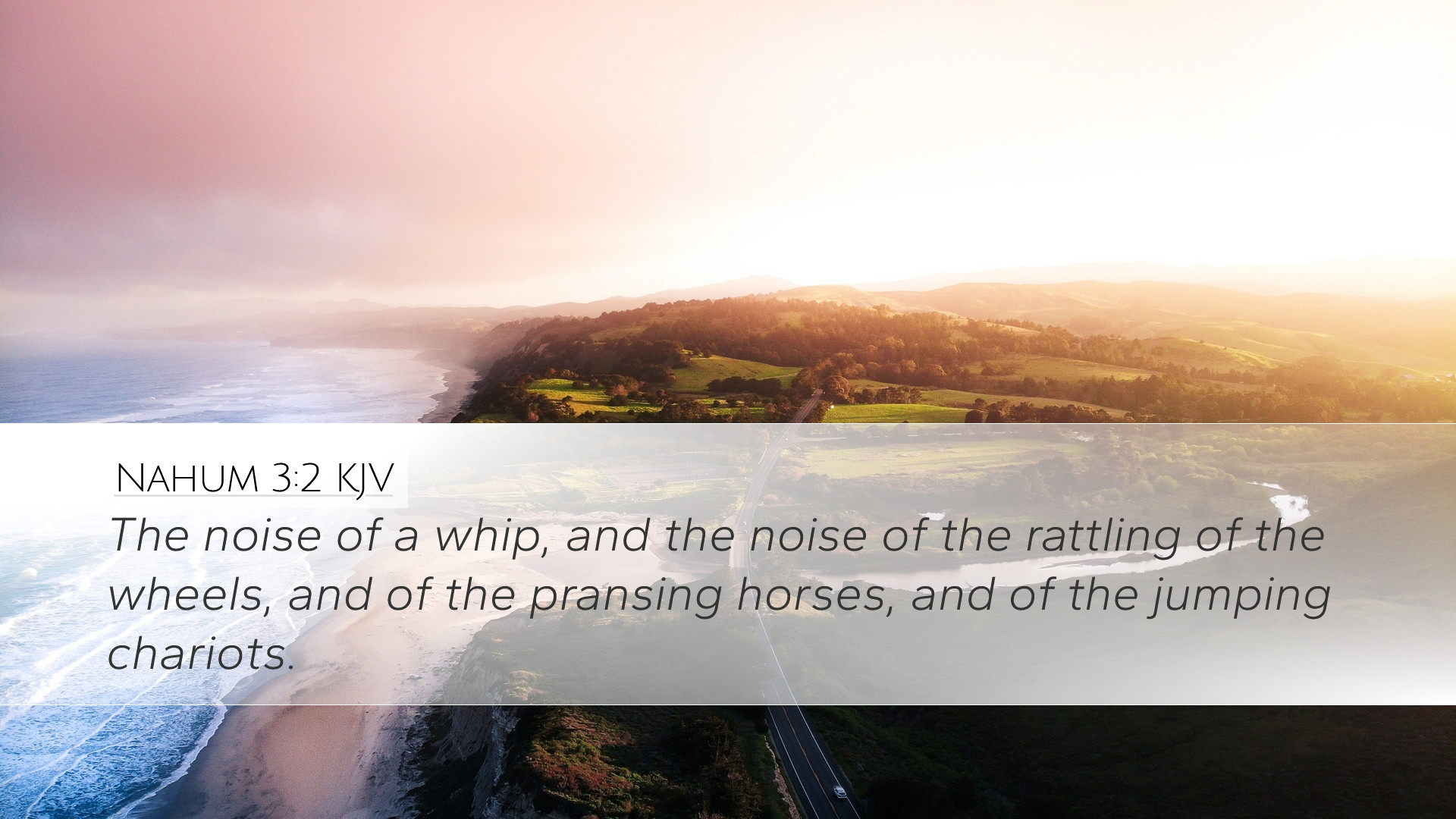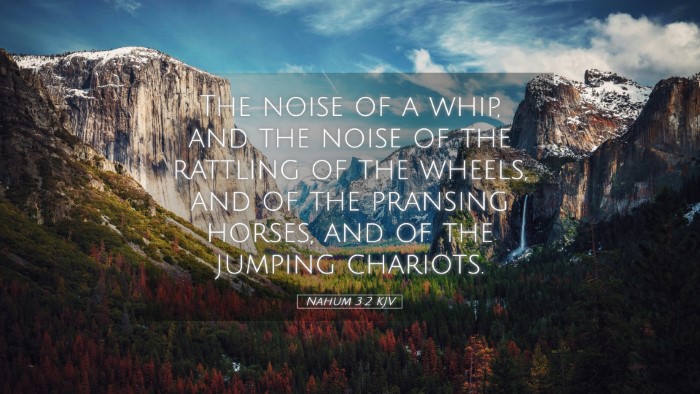Old Testament
Genesis Exodus Leviticus Numbers Deuteronomy Joshua Judges Ruth 1 Samuel 2 Samuel 1 Kings 2 Kings 1 Chronicles 2 Chronicles Ezra Nehemiah Esther Job Psalms Proverbs Ecclesiastes Song of Solomon Isaiah Jeremiah Lamentations Ezekiel Daniel Hosea Joel Amos Obadiah Jonah Micah Nahum Habakkuk Zephaniah Haggai Zechariah MalachiNahum 3:2
Nahum 3:2 KJV
The noise of a whip, and the noise of the rattling of the wheels, and of the pransing horses, and of the jumping chariots.
Nahum 3:2 Bible Commentary
Commentary on Nahum 3:2
Nahum 3:2 presents a vivid and compelling image that reflects the judgment of God upon the city of Nineveh. This verse states: "The noise of a whip, and the noise of the rattling of the wheels, and of the prancing horses, and of the jumping chariots." It serves as a profound proclamation of impending doom and offers rich theological insights worthy of exploration. Below is a comprehensive commentary drawing insights from notable public domain commentaries.
Context and Background
The Book of Nahum is a prophetic text that addresses the fall of Nineveh, the capital of Assyria, which was notorious for its violence, oppression, and the idolatry of its people. Traditionally seen as a continuation of the theme addressed in the previous prophetic book of Jonah, Nahum brings to light the certainty of divine retribution against those who reject God's authority and perpetuate evil.
Exploration of Nahum 3:2
In this specific verse, Nahum utilizes vivid auditory imagery to portray the chaos and destruction that accompanies the judgment of God. The mention of "the noise of a whip" suggests the aggressive, domineering force of an invading army. This reflects the very methods by which the Assyrians had historically imposed their will upon others.
The Symbolism of Sound
- Whip: The whip symbolizes punishment and domination. It conjures up images of cruelty and the power that oppressors wield.
- Rattling of the wheels: The rattling signifies the approach of chariots, suggesting the inevitability of invasion. This sound evokes fear and announces the arrival of devastation.
- Prancing horses and jumping chariots: These elements signify mobility and readiness for battle, portraying the speed of judgment that is about to befall Nineveh.
Theological Implications
From a theological perspective, Nahum 3:2 serves as a reminder of God's sovereignty and justice. The imagery illustrates not only the imminent judgment upon Nineveh but also serves as a warning to all nations that reject God's ways. The Assyrians, who once gleefully terrorized other nations, now face their due recompense.
Insights from Commentaries
Matthew Henry, in his exegesis, emphasizes the certainty of God’s judgment as inevitable and inescapable. He notes that this announcement of war against Nineveh is a divine response to her sins, illuminating the principle that divine justice is impartial and will ultimately be executed.
Albert Barnes expands on the themes of judgment, explaining that the sounds described symbolize the tumult that accompanies war. He argues that while Nineveh had imposed its will amidst the cries of the oppressed, the divine justice now responds with an even louder proclamation of destruction.
Adam Clarke provides a more pastoral perspective, urging readers to reflect on the consequences of sin. He highlights that the loud noises not only intimidate but also symbolize the profound spirituality of various judgments God applies against those steadfast in unrighteousness. Clarke sees the passage as a call to repentance and a recognition of divine authority among believers.
Lessons for Pastors and Theologians
Nahum 3:2 teaches several important lessons for those in pastoral ministry and theological study:
- The Reality of Judgment: There is a stern reminder that divine judgment is a real and present truth. Pastors must balance God's love and mercy with the seriousness of sin and judgment.
- The Call to Righteousness: This verse urges believers to maintain a lifestyle that is pleasing to God, recognizing that nation and individuals alike will answer for actions.
- Awareness of Consequences: The imagery of chaos encourages reflection on the chaotic consequences of straying from God's commands. Pastors should guide their congregants in understanding the gravity of persistent disobedience.
Practical Applications
For contemporary believers, Nahum 3:2 can be applied practically in several ways:
- Embrace God’s Justice: Believers should not shy away from the concepts of justice and judgment, which are integral to understanding God's character and purpose in human history.
- Foster Repentance: Encouragement towards repentance must be a key component in ministry, helping people recognize the path of destruction that sin leads to.
- Prepare for Christ’s Return: The sound of impending disaster can remind Christians of the need for readiness as we await the fulfillment of Christ's promise, illuminating the need for vigilance in faith and conduct.
Conclusion
Nahum 3:2 serves as both an indictment and a warning. It captures the climactic roar of judgment, declaring the fall of a once-mighty empire as it stands before the Almighty God. The lessons derived from this passage resonate with profound implications for all believers and leaders in ministry. As they engage with this text, they are reminded of the ultimate sovereignty of God in history and the necessity of repentance and righteousness.


